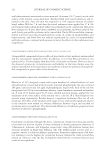NEXT-GENERATION NATURAL BABY BARRIER CREAM FORMULATIONS 179 fraction. Then, the required percentage amounts of surfactant were calculated according to the formula in the following text. Eight different cream formulations were prepared as mentioned earlier and prepared for 96 h at 4°C, and it was determined whether there was caking, creaming, and phase separation. The amount of required surfactant was calcu- lated according to the following formulation (24,25). 100 RHLB – HLB % = HLB – HLB B A A A % =100 – B A Microbiological anal ysis study. Microbiological analysis was performed for 96 h for all for- mulations. Samples that were sown on sheep blood agar were incubated for 4 d at 37°C, and it was checked whether the microorganism is produced. If there is microbial repro- duction as a result of incubation, further identifi cation must be performed for the deter- mination of the pathogen, which should not be included in the cosmetic legislation. Safety assessment study. This study attempts to evaluate the safety assessment of BBC and ingredients. BBCs are generally applied to the nappy area and mainly produce local expo- sure, although human systemic exposure may occur if each substance comes into contact with the mucous membrane of the oral cavity of the outer body of the human body. In the EU, United States, and Japan, the safety of BBCs is regulated under cosmetic and/or drug regulations. From this perspective, the exposure scenario of each substance in the cos- metic product was, respectively, evaluated, and the risk assessments were criticized (11,26). The amount of exposure to the components of cosmetic products is calculated from the singular concentration of each component in the fi nished product. It is necessary to cal- culate this exposure to assess the potential risk of raw materials. Individual exposure to the substances is calculated from the quantitative composition of the product. In the safety assessment made in cosmetic products, the exposure dose to the substances con- tained in the cosmetic product is expressed by the value of SED as mg/kg, body weight/d, and the calculation methods are given in the following text (26–28). * If the amount of dermal absorption (μg/cm2) on the unit surface is known, 2 –3 2 / × 1 0 / × × = 3.5 N Ng DAa g cm mg SSA cm F day–1 SED average newborn weight SED (mg/kg body weight/d): SED. DAa (μg/cm2): amount of derm al absorption at each cm2 on the skin surface. SSA: area of the skin surface that contacts with the fi nal product. NOAEL: results of tests which include teratogenicity, carcinogenicity, and long-term repeated-dose chronic toxicity. * Calculation method if the d ermal absorption amount of the applied product is known in %.
JOURNAL OF COSMETIC SCIENCE 180 NOAEL Mo = SED × Conc.% S p100 The MoS value is expected to be higher than 230 in baby products (29,30). When calcu- lating the dermal absorption, the calculations were made with the assumption that 100% of the product would be absorbed as the worst exposure scenario. The area where the applied pro duct touches the skin: 200 cm2, the amount of the applied product: 0.05 g. Contact time of the applied pr oduct: 30 s and frequency two times. RESULTS pH MEASUREMENT RESULTS The eig ht different barrier cr eam formulations were measured for pH analyses (n = 3). The pH results of the formulations were found between 6.9 and 7.8, and the pH of the optimum formulation BBC-8 was measured as 7.2. The pH measurement results of the formulations are given in Table 2 in the following text. VISCOSITY AND RHEOLOGICAL STUD Y RESULTS All formulation rheological pr operties have indicated a pseudoplastic fl ow property. BBC-1 and BBC-2 created a graph of shear rate fl uctuation across the applied shear stress, and the decrease in viscosity was not correlated with the shear rate. It was ob- served that the shear rate could not display the desired shear stress in the sixth formula- tion. The formulations BBC-3, BBC-4, BBC-7, and BBC-8 were determined by the graphics obtained that desired rheological character when there is increase in shear rates and viscosity values against the applied shear stress. As a result, the BBC-1, BBC- 2, and BBC-6 barrier cream formulations have not kept the rheological character and their stability during the shelf-life period. Viscosity and rheological measurement results of the formulations are represented in Figure 1. Table 2 pH Results of the Formulations (n = 3) Formulation code pH measurement result BBC-1 (K13/112) 7.104 ± 0.02 BBC-2 (K13/108) 7.263 ± 0.03 BBC-3 (K13/100) 7.203 ± 0.01 BBC-4 (K13/085) 7.836 ± 0.04 BBC-5 (K13/003) 7.326 ± 0.03 BBC-6 (K13/097) 6.957 ± 0.01 BBC-7 (K13/075) 6,693 ± 0.01 BBC 8- (K13/092) 7,263 ± 0.03
Purchased for the exclusive use of nofirst nolast (unknown) From: SCC Media Library & Resource Center (library.scconline.org)

























































































































